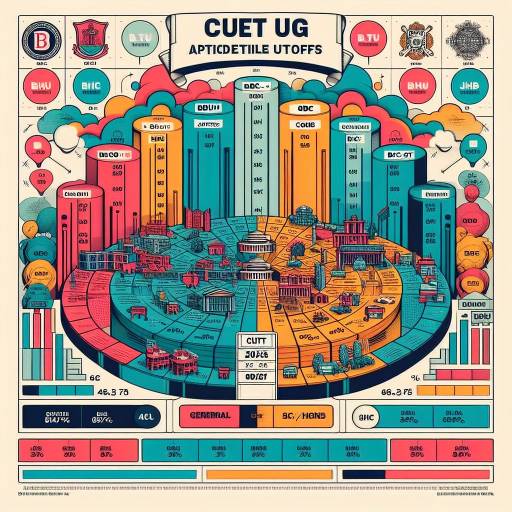Discover the CUET Cutoff 2024 for BHU, DU, and JMI. Get detailed college-wise and course-wise cut off marks to plan your admissions effectively. Stay updated with the latest CUET Cutoff 2024 trends and secure your spot in top universities
For applicants hoping to get admission to some of the most prominent colleges in India, the Common University Entrance Test (CUET) has emerged as a vital first step. The CUET Cutoff 2024 for Delhi University (DU), Jamia Millia Islamia (JMI), and Banaras Hindu University (BHU) is eagerly awaited, and knowing past trends might give prospective students important information.
Table of Contents
Understanding CUET Cutoffs
The Common University Entrance Test (CUET) is a pivotal examination for students aiming to gain admission into undergraduate programs at numerous prestigious universities across India. The CUET cutoff marks are a crucial aspect of this process, determining eligibility for various courses and institutions. This guide delves into the details of CUET cutoffs, elucidating how they are determined, their significance, and what students need to know to navigate them effectively.
What is CUET?
The CUET, administered by the National Testing Agency (NTA), is an entrance exam for undergraduate admissions into central universities and other participating institutions. The exam tests students’ knowledge and skills in subjects relevant to their desired courses, and the scores are used to rank and select candidates for admission.
What are CUET Cutoffs?
The CUET cutoff marks are the minimum scores that candidates must achieve to qualify for admission to a particular course at a specific university. These cutoffs vary widely depending on several factors, including the university, the course, the category of the candidate, and the overall performance of all applicants in that year.
Factors Influencing CUET Cutoffs
- Number of Applicants: Higher the number of applicants for a particular course, higher the competition, which often leads to higher cutoffs.
- Difficulty Level of the Exam: If the exam is particularly tough in a given year, cutoffs may be lower as fewer students would achieve high scores.
- Availability of Seats: Courses with fewer seats tend to have higher cutoffs due to limited availability.
- Category of Candidates: Cutoffs are generally lower for reserved categories (such as OBC, SC, ST, and PwD) compared to the general category.
- Previous Year’s Trends: Historical data on cutoffs help in setting a benchmark for current year’s cutoffs, providing a reference point for both institutions and students.
- Institutional Reputation and Demand: Prestigious institutions or highly sought-after courses often have higher cutoffs.

Table of CUET Cutoff 2024
| University | Course | General Category | OBC Category | SC/ST Category |
|---|---|---|---|---|
| BHU | B.A. (Hons) Arts | 210-260 | 190-230 | 160-190 |
| BHU | B.Sc. (Hons) Mathematics | 260-290 | 240-270 | 210-240 |
| BHU | B.Com (Hons) | 230-270 | 210-250 | 180-220 |
| DU | B.A. (Hons) English | 290-310 | 270-290 | 250-270 |
| DU | B.Sc. (Hons) Chemistry | 280-300 | 260-280 | 230-260 |
| DU | B.Com (Hons) | 300-320 | 280-300 | 250-280 |
| JMI | B.A. (Hons) History | 230-260 | 210-240 | 190-220 |
| JMI | B.Sc. (Hons) Physics | 250-280 | 230-260 | 210-240 |
| JMI | B.Com (Hons) | 250-280 | 230-260 | 200-230 |
Banaras Hindu University (BHU) Cutoff Trends
BHU is renowned for its diverse range of courses and competitive admission process. The CUET cutoff trends for BHU reflect the university’s high academic standards and popularity among students.
official website for Admission: Banaras Hindu University
Previous Trends:
- B.A. (Hons) Arts: The cutoff for B.A. (Hons) Arts generally ranges from 200 to 250 marks for the general category. OBC and SC/ST categories typically see lower cutoffs, around 180-220 and 150-180 respectively.
- B.Sc. (Hons) Mathematics: For this course, the cutoff has been around 250-280 for general category candidates, with OBC and SC/ST categories requiring scores around 230-260 and 200-230 respectively.
- B.Com (Hons): This highly sought-after course sees cutoffs around 220-260 for general candidates, while OBC and SC/ST categories might see cutoffs around 200-240 and 170-200 respectively.
Delhi University (DU) Cutoff Trends
Delhi University, with its extensive list of affiliated colleges, remains one of the most popular choices for CUET aspirants. The cutoffs for DU tend to be quite high, reflecting its academic prestige and the volume of applicants.
Previous Trends:
- B.A. (Hons) English: The cutoff for B.A. (Hons) English has been significantly high, often ranging between 280 to 300 for the general category. OBC cutoffs typically range from 260 to 280, while SC/ST categories might see cutoffs between 240 and 260.
- B.Sc. (Hons) Chemistry: For B.Sc. (Hons) Chemistry, the general category cutoff generally falls between 270 to 290. OBC candidates might require around 250-270, and SC/ST candidates around 220-250.
- B.Com (Hons): One of the most competitive courses, B.Com (Hons) often has cutoffs between 290 to 310 for general candidates. OBC cutoffs range from 270 to 290, and SC/ST categories usually have cutoffs between 240 and 270.
Jamia Millia Islamia (JMI) Cutoff Trends
JMI is another premier institution where CUET cutoffs are keenly awaited. The university offers a wide range of courses, and its cutoffs reflect a mix of competitive and accessible standards depending on the course.
Previous Trends:
- B.A. (Hons) History: The cutoff for this course typically ranges from 220 to 250 for general candidates. OBC candidates might see cutoffs around 200-230, and SC/ST candidates around 180-210.
- B.Sc. (Hons) Physics: For B.Sc. (Hons) Physics, the general category cutoff is usually between 240 to 270, with OBC cutoffs around 220-250 and SC/ST cutoffs between 200-230.
- B.Com (Hons): The B.Com (Hons) course at JMI generally has cutoffs ranging from 240 to 270 for the general category, 220-250 for OBC candidates, and 190-220 for SC/ST candidates.
Predicting the CUET 2024 Cutoff
While predicting the exact CUET 2024 cutoff is challenging, we can make educated guesses based on previous trends and current factors. Here are some expected trends:
- BHU:
- B.A. (Hons) Arts: General category around 210-260, OBC 190-230, SC/ST 160-190.
- B.Sc. (Hons) Mathematics: General category around 260-290, OBC 240-270, SC/ST 210-240.
- B.Com (Hons): General category around 230-270, OBC 210-250, SC/ST 180-220.
- DU:
- B.A. (Hons) English: General category around 290-310, OBC 270-290, SC/ST 250-270.
- B.Sc. (Hons) Chemistry: General category around 280-300, OBC 260-280, SC/ST 230-260.
- B.Com (Hons): General category around 300-320, OBC 280-300, SC/ST 250-280.
- JMI:
- B.A. (Hons) History: General category around 230-260, OBC 210-240, SC/ST 190-220.
- B.Sc. (Hons) Physics: General category around 250-280, OBC 230-260, SC/ST 210-240.
- B.Com (Hons): General category around 250-280, OBC 230-260, SC/ST 200-230.
Strategies for Aspiring Candidates
To increase your chances of securing admission into your desired course and university, consider the following strategies:
- Early Preparation: Begin your CUET preparation early, focusing on the core subjects relevant to your desired course.
- Mock Tests and Past Papers: Regularly practice with mock tests and previous years’ question papers to get a feel for the exam pattern and difficulty level.
- Time Management: Develop strong time management skills to ensure you can complete the exam within the allotted time.
- Focus on Weak Areas: Identify and work on your weak areas to improve your overall score.
- Stay Updated: Keep an eye on official notifications from NTA and the respective universities for any updates regarding the CUET exam and admission process.
Conclusion
The CUET 2024 cutoff for BHU, DU, and JMI is a crucial milestone for many aspirants. By analyzing previous trends and understanding the factors that influence these cutoffs, candidates can better prepare themselves for the challenges ahead. Remember, a strategic approach to preparation, coupled with diligent effort, can significantly enhance your chances of success in securing admission to these prestigious institutions.

